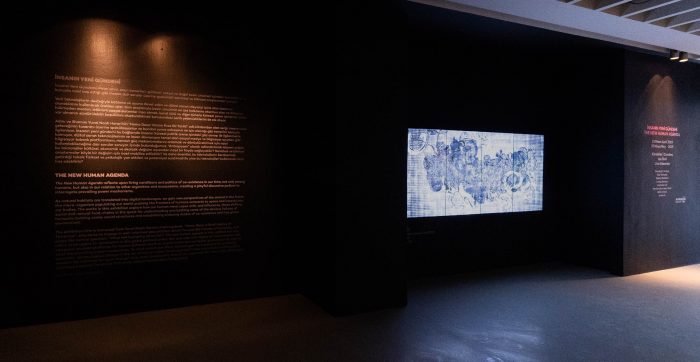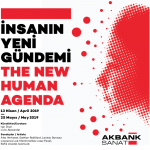The New Human Agenda

VENUE
AKBANK SANAT, ISTANBUL
13 APRIL – 25 MAY 2019
Artists:
Alex Verhaest | Gaëtan Robillard | Larissa Sansour | Lawrence Lek | Marshmallow Laser Feast | Refik Anadol | teamLab
Curators:
Işın Önol & Livia Alexander
The New Human Agenda reflects upon living conditions and politics of co-existence in our time, not only among humans, but also in our relation to other organisms and ecosystems, creating a playful discursive podium to interrogate prevailing power mechanisms.
As natural habitats are translated into digital landscapes, we gain new perspectives of the animal in the forest, the micro-organism populating our world, pushing the frontiers of humans outwards to space and inwards into our bodies. The works in this exhibition explore how our human mind copes with, and influences, these shifting social and natural food-chains in the quest for understanding and battling some of the obvious failures of humanity building stable social structures and establishing enduring modes of co-existence with the global environment.
The exhibition title is borrowed from Yuval Noah Harari’s inspiring book, “Homo Deus: A Brief History of Tomorrow”, who dares to engage in well-informed speculations about the possible futures of humanity, and poses the central question, “What will humanity strive for?” The new human agenda in this context not only refers to struggles for dominance in the global political arena, but also asks how digital art technologies and computer-enabled platforms for human behavior (such as social media and computer games) can be used to twist the prevailing power mechanisms. To what extent can these technologies be employed for a cultural, economic, and ecological change in the era of the so-called “Anthropocene”? How can artistic and scientific research be mobilized for such change? And, most importantly, how do we cope with the toxic side-effects and enormous potential for abuse that great, potent technologies bring along?
CATALOGUE
PRESS
May 10, 2019, Gazete Duvar; “Yeni Medya Sanatı Meseleleri: İnsanın Yeni Gündemi“, by Kültigin Kağan Akbulut (Turkish)
May 3, 2019, TRT World, “The New Human Agenda“, Exhibitions, Showcase
May 2, 2019, Hürriyet: “İnsanın Geleceğini Tasarlamak“, Author unknown (Turkish)
April 26, 2019, Star: “Nedir bu İnsanın Yeni Gündemi“, by Ali Demirtas (Turkish)
April 16, 2919, Yeni Şafak: “Gerçekliği tartışmaya açıyor“, by Seray Şahinler Demir (Turkish)
April 15, 2019, Türkiye: “İnsanoğlu, gelecekte acaba ne hâle gelecek?“, by Murat Öztekin (Turkish)
April 3, 2019, Aydınlık: “Akbank Sanat’tan yeni sergi: ‘İnsanın Yeni Gündemi‘“, selected listing (Turkish)
The recent, multifaceted work of Alex Verhaest Temps Mort/Idle Times, is a reflection about our ever-failing relationship with time and the temporal paucity one experiences while using social media, subtly interweaving today’s networked communication environment with the humanistic tradition of the Northern Renaissance. It uses a loose, skeletal structure to gather a heterogeneous series of works around a common narrative, the effect of the suicide of an absent pater familias on his family, who find themselves simultaneously incapable of mourning or adequately dealing with the loss, and are accorded a specific subjective position in relation to this event, conveyed through a series of portraits.
In The Diner Scene, the dead father’s offspring are gathered around “Angelo,” the narrator, and are depicted both before and after hearing of their father’s passing. They are thus suspended in a psychological limbo, their ambivalence precipitating a profound psychic blockage, manifested in a series of lugubrious monologues. This video, which at first glance is easily mistaken for a static work, is activated via mobile phone, when visitors telephone “Peter,” whose number is provided on the wall.
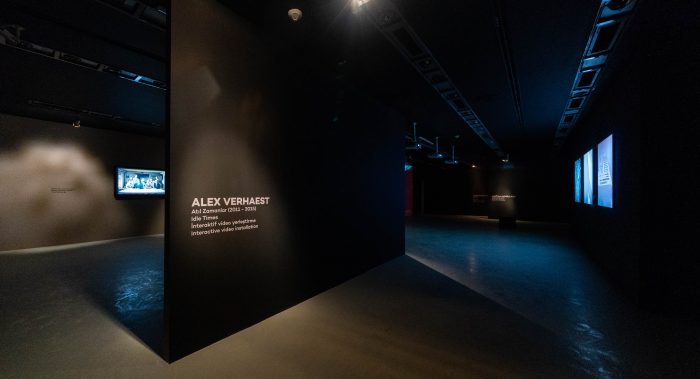
The script of Idle Times / Temps Mort operates as the narrative backbone for a series of works on the suicide and character assassination of an absent pater familias, and the incapacity of the family members to communicate on, and to deal with this tragic event. The protagonists of Idle Times/ Temps Mort, the ‘mourning’ relatives (Hélène, Dolores, Peter and Madeleine) and the storyteller (Angelo) are introduced via a series of 5 Characters Studies: a series of portraits that visualize the internal emotional struggle and inaptitude of the surviving relatives to adopt an adequate attitude. Each character study corresponds with a so-called Table Prop, operating as allegoric representations of the protagonists and their mental states.

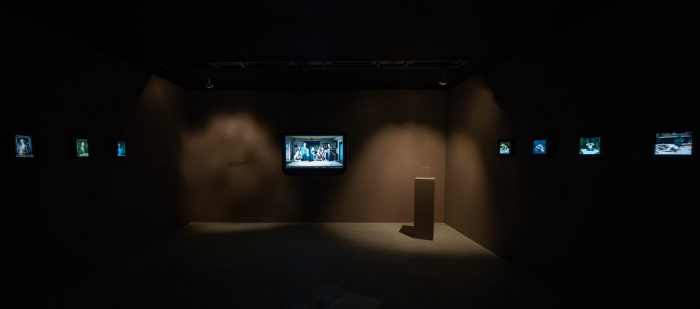

In Search of a Wave by Gaëtan Robillard is inspired by the story of Henri Charriere, a convict at the penal colony Devil’s Island in Cayenne, French Guiana, who used basic counting techniques to familiarize himself with the movement of the ocean’s waves, enabling him to plan his escape from the island.
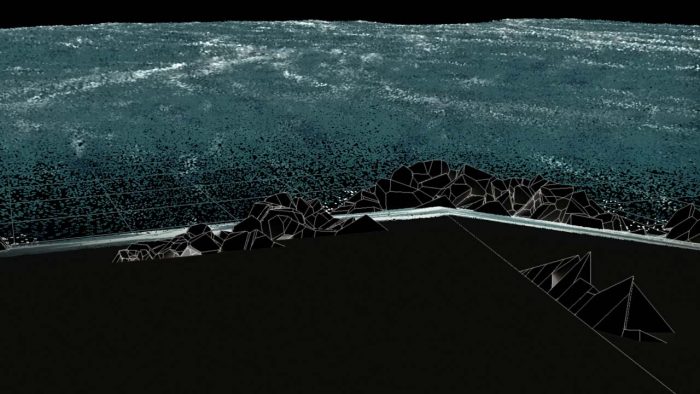
The computer simulation depicts the surroundings of Devil’s Island: the grid that looms over the seafloor, and the pixelated waves composed of millions of particles in endless motion. These significant visual components participate in a now-familiar aesthetic linked to fantasies of computation able to continually map and order the world. Through engagement with particularly visible forms of digital prosthesis, emerging conceptions of new spatiotemporal relations become indiscernible from the processes employed to generate these images.

Memoirs from Latent Space – Study I is a collection of three works that consider the relationship between memory and dreams, recognition and perception, by exploring the space in the mind of a machine. Utilizing machine intelligence, this collection of artifacts illuminates the seemingly unknowable. In this work, Refik Anadol uses a neural network that draws on 1.2 million images of architectural photographic memories from the buildings of 9 architects and 11 different historic eras. This manufactured space is imaginary and yet recognizable to the human eye, thus illustrates a dreamscape of possible futures and hidden pasts.

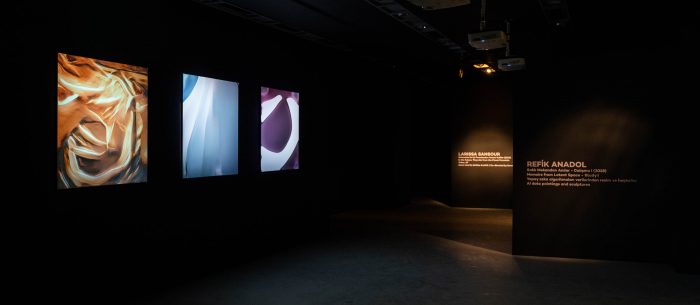

In the Future, They Ate from the Finest Porcelain by Larissa Sansour takes the form of a fictional video essay. A voice-over based on an interview between a psychiatrist and the female leader of a narrative resistance group reveals the philosophy and ideas behind the group’s actions. The leader’s thoughts on myth and fiction as constitutive for fact, history and documentary, translate into poetic and science fiction-based visuals.
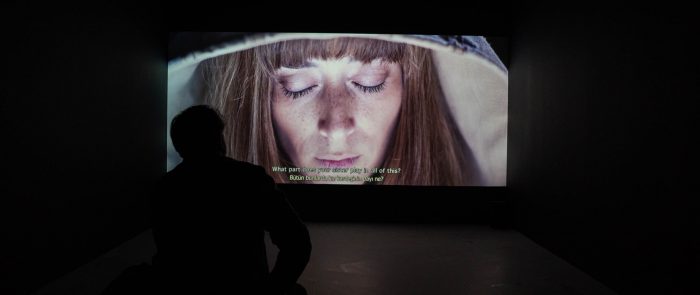
As the film progresses, the narrative and visuals alternate between the theoretical and the personal. The resistance leader’s deceased twin sister makes a crucial appearance as the story takes the viewer deeper and deeper into the resistance leader’s subconscious.


2065 is an ‘open-world’ video game teleporting players between five zones set on a virtual island, simulating various locations in Singapore, Malaysia, and Hong Kong. The work speculates the eventual effects of AI’s advance, when humanity eventually relinquishes even creative tasks to robots.
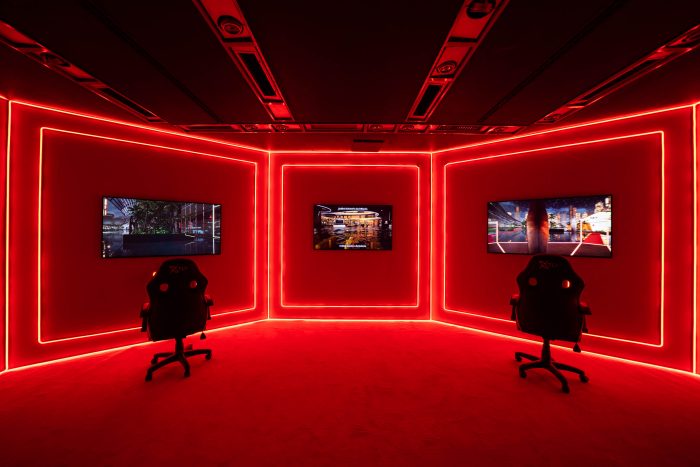
Simulating a world when all humans have left to do is play in virtual landscapes controlled by an omnipresent corporation, Lawrence Lek asks players to reflect on the ramifications of a world increasingly driven by technology, reality and simulacra become one and the same, and humans vanish from these man-made landscapes, squared away in front of their screens.


In the Eyes of the Animal by Marshmallow Laser Feast invites us to consider reality beyond our human limits by seeing the forest through the eyes of a bird of prey gliding above the forest canopy, a dragonfly on a log, and a frog in the swamp, using audio recordings sourced from Grizedale Forest in the North of England. Creating a color palette that imagines higher CO2 density as a red hue, the trees breathe, sucking in the red and exhaling a cooler palette of oxygen. ITEOTA creates a better understanding of how other mammals process optical information and to give people a chance to reflect on their own visual perceptions of the forest.
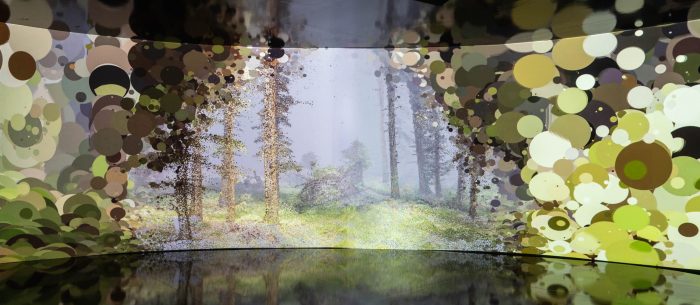

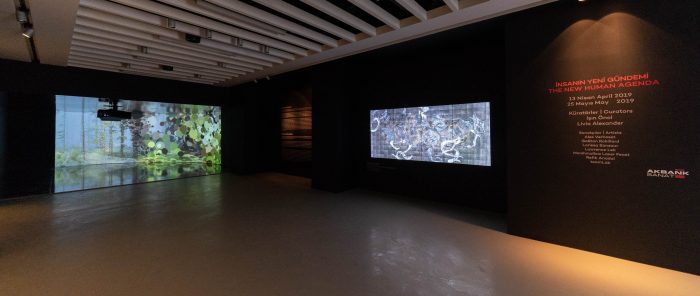
From the art collective teamLab composed of a wide swath of digital practitioners in CG animation, graphic design, architecture and engineering, Impermanent Life follows the rhythmic flow of the water and flower petals that permeate the screen, as cherry blossoms spread and scatter across its surface. In the background, a circle grows and shrinks in regular gestations in a meditative gesture, calling to mind watercolours and landscape scroll paintings that have been a part of the Japanese canon for centuries. Transforming the world of nature and the world of screens, Impermanent Life nevertheless insists on the ephemerality, artificiality, and fleeing delicateness of the digital.

